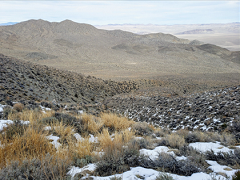BLM seeks public comment on range improvement projects in eastern Inyo County
Organization:
BLM Office:
Media Contact:
RIDGECREST, Calif. – The Bureau of Land Management (BLM), Ridgecrest Field Office, is seeking public comment on the environmental assessment for proposed range improvements in two grazing allotments located in Deep Springs Valley, the Piper Mountains, and Fish Lake Valley in eastern Inyo County. The deadline to submit public comments is March 29.
The project proponent and grazing permittee, Deep Springs College (Board of Trustees), has proposed the construction, use, and maintenance of eleven range improvements in the Deep Springs Valley and South Oasis grazing allotments, including seven water trough sites, two water pipelines, one permanent corral, and one water tank. If approved, the changes would help reduce the impacts at existing watering sites, protect resources, and allow for a more even distribution of cattle throughout the Deep Springs Valley and South Oasis allotments. The construction of proposed range improvements would result in less than one acre of surface disturbance in vegetation primarily characterized by desert alkali scrub. When possible, proposed range improvement features would be located in previously disturbed areas, or in natural clearings and weed-free areas.
The environmental assessment is available for review online at https://go.usa.gov/xs9VC. Members of the public may submit substantive written comments by March 29, 2021 at [email protected]; via ePlanning at https://go.usa.gov/xs9VC; or by fax at 760-384-5499.
The BLM manages about 245 million acres of public land located primarily in 12 western states, including Alaska, on behalf of the American people. The BLM also administers 700 million acres of sub-surface mineral estate throughout the nation. Our mission is to sustain the health, diversity, and productivity of America’s public lands for the use and enjoyment of present and future generations.

